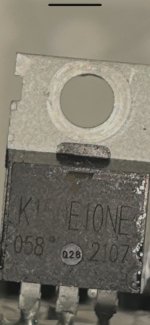The chip reads: K150E10NE across the middle, 058 in bottom left corner and 2107 in bottom right.
I don't see a datasheet in a quick search, but this is the "next model down"
MOSFET, Datasheet, equivalent, pinout, replacement, pdf, complementary.

datasheetspdf.com
though I don't know how much different it is. Knowing that the original was a Toshiba it should be possible to find their original datasheet, even if one isn't available for the "clone".
You can also use the chat on digikey or mouser and ask them for the closest replacement they have to what you've got; they might be familiar enough with it to do so.
I’m not opposed to replacing all of them for something that is more up to the task. I’m just not sure what that would be. Maybe something from TI or other known manufacturer with a good reputation.
Just have to find the original specs so you get one that will be the closest match to the drive specs (presuming the drive hardware is made for those FETs; if it's not then there's no data to go on and you could try anything that meets minimum voltage and current and max resistance).
Heat sink grease was inadequate in my opinion. The center section between the aluminum plate and case was dry on the case. The plate had paste, but clearly was not making good contact with the case.
If the plate / bar paste was not transferred to the case, then the bar is not touching the case there, and is not transferring any heat to the case along that entire surface area that isn't touching. This is not uncommon, and is usually because of a bent bar or non-flat case extrusion, and requires re-machining or lapping to fix if necessary. Sometimes you can fix it by adding more bolts between the two along the length of the bar, thru the case, but it may just deform the case skin locally to the bolt head and not force the two toegther along their entire surface area as desired.
The connection with the mosfet to the plate had kapton tape between the feet and the thermal compound. I’m not sure if this is usual practice or not.
The tape is there to prevent electrical shorts between phases; sometimes they use grey silpads instead, because kapton is VERY thin and easily damaged...if there is any electrical contact from FET to heatsink and the heatsink connects to any other FET in a different phase, or any other electrical potential relative to what is on that FET, you can get POOF.

Heatsink paste should be practically not there, because it is only intended to fill any teensy tiny air gaps in scratches and surface defects (because it's better than air by far, but not as good as metal-to-metal contact).
If you look up various pages on overclocking CPUs, or power amplifiers, etc., stuff that has to get rid of a LOT of heat, you'll find various methods of application, but essentially if the surfaces are correctly manufactured and parallel to each other, and actually flat, you only need to scrape enough grease on there to fill the surface scratches, and then when you mate the surfaces metal will touch metal everywhere it can, and metal to grease to metal where it can't.
If the surfaces are not correctly made, they could have large areas that will never touch, and the grease has to fill those gaps...but grease often dries out over time and contracts, leaving air gaps which are great insulators, reducing the heatsinking ability of the system. So the greater the metal-metal contact is, the better. There's a technique called lapping that can correct poor fit, but it's tedious and time consuming and not usually necessary (but helpful when there are really badly fitting surfaces).
If you can't tell if they fit, and you can't fix it, then it's safer to apply a thin, even coat of grease to one surface, so you can't see the surface and the ohter surface you scrape with grease-covered plastic sheet (credit card, etc) to just fill it's defects. Then clamp both surfaces together with their mounting bolts, and hope they make sufficient contact and have enough evenly applied force to squeeze all the excess grease out from between the metal surfaces so they make as much direct contact as possible.
How much practical difference any of it makes depends on how much heat is really generated, and how much sinking ability the outside air has (> difference in temperature = better, > airflow = better). If ther'es lots of cool air flwoing and not much heat generated, you could prbably leave it with no grease and a poor fit and be ok.....
Whle I did plenty of lapping/cooling mods/etc for CPU overlocking a couple decades ago, the most I have usually done on a controller was "safer" method I noted up above, but I haven't had one overheat and cause problems to require more (had one explode it's FETs from overload in a motor-stall test, but I don't think heatsinking had time to get heat out even if it was perfect; the controller just wasn't designed with proper safety limits).



